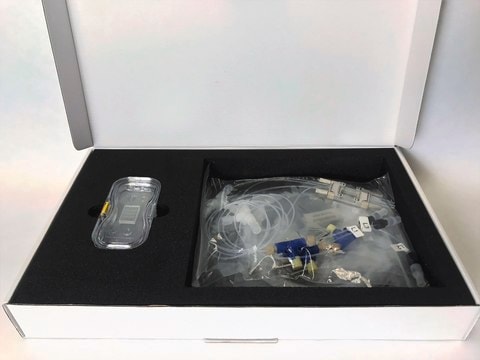T1503
Trizma® base
≥99.9% (titration), crystalline, primary standard, aminopeptidase substrate
Synonym(s):
2-Amino-2-(hydroxymethyl)-1,3-propanediol, THAM, Tris base, Tris(hydroxymethyl)aminomethane, Trometamol
About This Item
Recommended Products
product name
Trizma® base, Primary Standard and Buffer, ≥99.9% (titration), crystalline
Quality Level
description
aminopeptidase substrate
Assay
≥99.9% (titration)
form
crystalline
storage condition
dry at room temperature
technique(s)
ELISA: suitable
protein extraction: suitable
color
white
pH
10.5-12
useful pH range
7-9
pKa (25 °C)
8.1
bp
219-220 °C/10 mmHg (lit.)
mp
167-172 °C (lit.)
solubility
methanol: soluble 26 mg/mL at 25 °C
ethylene glycol: soluble 79.1 mg/mL at 25 °C
water: soluble (678 g/l at 20 °C)
absorption
≤0.05 at 290 nm at 40%
suitability
suitable for Western blot
suitable for electrophoresis
application(s)
cell analysis
diagnostic assay manufacturing
life science and biopharma
SMILES string
NC(CO)(CO)CO
InChI
1S/C4H11NO3/c5-4(1-6,2-7)3-8/h6-8H,1-3,5H2
InChI key
LENZDBCJOHFCAS-UHFFFAOYSA-N
Looking for similar products? Visit Product Comparison Guide
Related Categories
General description
Tris base may find application as basimetric standard, independently as a buffer and as a crucial component in mixed buffer formulations, including Tris-EDTA (TE) buffer, TAE buffer, TBE buffer, among others. Its attributes include purity, essential stability, and a relative non-hygroscopic nature, making it a dependable choice in laboratory settings. In these environments, Tris base is indispensable for preparing buffers compatible with biological fluids and serves as a standard pH solution. It facilitates various laboratory procedures such as lactate dehydrogenase assays, in situ hybridization, and protein extraction from cells. The versatility of Tris base extends to cell biology, biochemistry, and protein research contributing significantly to studies involving cell membrane permeability and buffer preparation.
Application
- as a component of H buffer (cell dissociation buffer)
- for washing and saturation of wells in double sandwich ELISA immunoenzymatic technique
- as an assay buffer for reconstitution of extracted and dried protein samples
- to prepare Tris-HCl buffer that is used to stabilize proteins
- as a buffer to extract carotenoid from tubers
- as a component of sample buffer during protein extraction prior to western blotting
- as a component of sample buffer for sodium dodecyl sulfate polyacrylamide gel electrophoresis (SDS-PAGE)
- to prepare simulated body fluid (SBF) for calcium phosphate (CaP) resorption assay
- as a buffer for polydopamine (PDA) deposition on stainless steel (SS) substrate
Features and Benefits
- Efficient buffering within the pH range of 7 - 9 with a pKa of 8.1 (25 °C)
- Tested to confirm low levels of heavy metal contamination, ensuring suitability for various applications
- Can be used in Cell Biology, and Biochemical research
Other Notes
For precise applications, use a carefully calibrated pH meter with a glass/calomel combination electrode.
Legal Information
also commonly purchased with this product
comparable product
suggested gloves for splash protection
Storage Class Code
11 - Combustible Solids
WGK
WGK 1
Flash Point(F)
Not applicable
Flash Point(C)
Not applicable
Personal Protective Equipment
Certificates of Analysis (COA)
Search for Certificates of Analysis (COA) by entering the products Lot/Batch Number. Lot and Batch Numbers can be found on a product’s label following the words ‘Lot’ or ‘Batch’.
Already Own This Product?
Find documentation for the products that you have recently purchased in the Document Library.
Customers Also Viewed
Articles
AEM3-944 | UAT | Prefill feature for related product categories not working
AEM3-944 | UAT | Prefill feature for related product categories not working
AEM3-944 | UAT | Prefill feature for related product categories not working
AEM3-944 | UAT | Prefill feature for related product categories not working
Protocols
This procedure may be used for determination of Endoproteinase Glu-C enzymatic activity using N-t-Boc-L-glutamic acid α-phenyl ester as the substrate.
Enzymatic Assay of Achromopeptidase
Objective: To standardize a procedure for the assay of Carboxypeptidase A
Objective: To standardize a procedure to determine the enzymatic activity of Luciferase and/or to determine the ATP detection limit of Luciferase.
Related Content
Test for Rollout & Branddefensing 0718
Our team of scientists has experience in all areas of research including Life Science, Material Science, Chemical Synthesis, Chromatography, Analytical and many others.
Contact Technical Service




